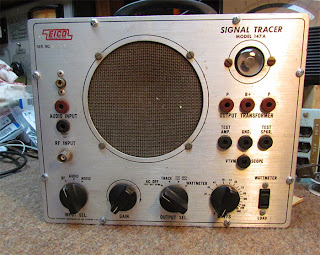Here's a case in point. Just finished the little Rickenbacker amp (which has now become my lap steel practice amp). I have another small amp I'm going to work on, but I need a couple parts for it. So in the meantime this Eico 147A Signal Tracer has jumped the line and is on the bench.
I've been sort of window shopping for one of these for a while, and just procured this one.
This is a device which you use to 'trace' an electronic RF or audio signal through a piece of gear (a radio, an amp) to troubleshoot it. You use a probe connected to the tracer on each part of the circuit. The tracer amplifies the signal. So if you get signal at a part of the circuit, you know it's good. If not, your trouble is in that area. Very handy for old radios.
Anyway, the thing about cool old test gear is that it too may need to be restored before you can use it. So I'm checking this out before I put it to work.
On opening this up, I got a surprise - a nice one. This thing is extremely clean, and virtually unused.
You can see the markings on the chassis. Usually these are gone over time, but this chassis is almost as new.
Eico, like Heathkit, offered test gear as a kit or as factory assembled. Electronic hobbyists were not uncommon in the 1950s and 60s. Most of this stuff I've seen and own was built from a kit.
This one however, was factory assembled. Here's the "TESTED" stamp on the back of the chassis that proves it. We also have the test date - March 5, 1965. All of the date codes on the components are late 1964, so this makes sense.
Again, this sort of stamp is mostly gone on old gear, but it's intact here.
The icing on the cake (mmmmm cake....) are the three Eico-labelled tubes in perfect condition. The preamp tube is a Mullard 12AX7A. These English-made tubes are in high demand. This tube is probably worth at least twice what I paid for the whole 147A.
I'm going to take it out for safekeeping.
I tested the cap can and it shows no leakage, so I'm not going to restuff it. I will probably not use the tester that much. If the cap starts to go bad, I'll mess with it later.
One thing I am going to fix is the screen over the speaker. It's got a dent, which you can see.
It also was "flocked" with a black flock material. Most of the flocking is gone, so I'm going to re-flock it.
Aside: nobody knows what flocking is anymore! I knew exactly what had been on the screen when I saw it. I went to my local Michael's (chain crafting store) and they directed me to sparkles. No no no! Wound up ordering it online.
By the way, that fuzzy stuff in your car's glovebox or coin tray? Flocking.
In the process of taking the speaker out, I discovered a small tear in the speaker cone. So I need to patch it. The method I use will work for smallish tears. If there are big hunks of cone missing, you're out of luck and will need a recone (or a new speaker).
The Antique Radios Forum (see my links to the right) is a great resource for these kind of "how-to" ideas. Some folks will use coffee filters (not bad), but I tried fabric backing material based on someone's suggestion and now it's what I use.
The picture shows what fabric backing looks like. One side is colored and the other side is 'spackled.' I bought a yard of the stuff 12 or so years ago and I still have 95% of it left. It's my lifetime supply.
Cut a patch to suit and glue it to the cone with general purpose glue - I use Elmer's white glue.
You'll note a second patch. Stoopid me laid the speaker on the tracer chassis (I didn't bother to disconnect it), and the little nipple on the top of the tube (the exhaust vent for the vacuum, see the arrow) poked a little hole. So I fixed that one too.
Lesson here is speaker cones are made of paper (old ones anyway). Don't forget that they're fragile!
After the glue dries, you have a good repair.
The tracer has this way cool tuning eye. These were prevalent in on 1930s and 40s radios and test gear through the 60s. The little wedge in the bottom of the eye will close up with a stronger signal.
On a radio, it's a tuning indicator - the eye "closes" on a strong station's signal, giving a visual indication of signal strength. In this case, the eye will close on a strong signal in the circuit.
It's fun to sit in a dark room listening to an old radio with just the dial light and a tuning eye illuminating the room.












0 comments:
Post a Comment